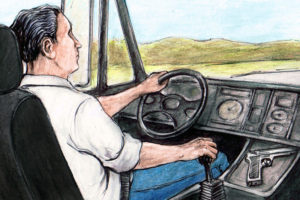CAITLIN KELLY
JUNE 12, 2017
https://www.trucks.com/2017/06/12/truckers-guns-taboo-topic/
The Mustardseed Truck Stop on Highway 167 in Sumner, Wash., wins little love: “filthy,” “disgusting,” “overpriced” are but a few of the many scathing reviews offered by truckers reluctantly paying $13 for a 12-hour break on its premises.
It’s also a former crime scene, where, on March 8, 2016, 52-year-old Piotr Pietrzykowski was stabbed to death in his white cab. He was driving for Top Line Express, a company founded in 2011 in Schaumburg, Ill.
His violent death, reported only by the local media, remains unsolved more than a year later.
Pietrzykowski’s slaying is one of 27 reported driver killings nationwide between 2010 and 2015, according to Bureau of Labor Statistics’ data. It also prompted a debate on whether truckers should be allowed to carry guns for protection.
“It’s the Wild West. You’re on your own,” said Norita Taylor, spokeswoman for the Owner Operator Independent Drivers Association, which represents 158,000 members.
Unlike the Wild West, though, where many carried a six-shooter and rarely hesitated to use it in their own defense, today’s drivers face a much different and more challenging environment.
Frustrated drivers are increasingly at risk as a drastic shortage of parking — an estimated 300,000 spots are available for more than 3 million drivers — makes dark, remote spots the default place for mandatory rest.
Truckers most often were killed on duty — 12 slayings — while parked on a local road, street or highway, according to BLS data. Another seven were killed in a parking lot or garage not owned by their direct employer. Truck drivers were the victims of 5 percent of reported workplace homicides between 2011 and 2015, according to the federal agency.
While there is no national law prohibiting truckers from carrying properly permitted firearms, it’s still a questionable practice. Myriad city, county, state and trucking company policies make it nearly impossible for truckers to legally carry firearms in their trucks.
That leaves drivers who choose to bring a firearm on the road caught between complicated state and local laws, and their fear of being attacked while alone and far from help.
“You have a very deep need for national reciprocity so that our rights for self-defense get extended across the United States,” said Evan Nappen, an attorney in Eatontown, N.J., who concentrates on firearms and weapons law. “Most civilians are not as concerned with this issue, but this is drivers’ living.”
But others said there is little data available that would show whether firearms would better protect drivers from crime.
“I think you have to weigh the safety and security of the truckers and whether the ability to carry a weapon increases their ability to protect themselves,” said Tim Lytton, a law professor and gun regulation expert at Georgia State University. “We don’t know the extent to which arming truck drivers or allowing them to carry across jurisdiction is going to increase their safety or decrease their safety.”
Even if a driver has the legal right to own, or carry, a firearm in his or her home state, each state, and sometimes each county or even municipality — like New York City, Chicago and Washington, D.C. — may impose its own much tougher laws.
A driver found carrying a gun in New Jersey faces a minimum mandatory prison sentence of 3 ½ years and as much as 10 years, Nappen said. He recently successfully defended a Marine, a military police officer who brought his MP-issued handgun home to New Jersey from his workplace in Quantico, Va.
“Truckers are more likely to have this problem than anyone I can think of,” he said. “They know they’re vulnerable to violence, and they also don’t realize how harsh New Jersey law is. The individual has to choose between who they fear more, cops or criminals.”
Short of guns, drivers are relying on other things they are allowed to carry in their cabs and which they can use as weapons, including club-like objects such as heavy-duty MagLite flashlights, tire irons and pry bars. Some take dogs in their trucks to alert them if someone gets too close to their cab.
Robert Palm, a father of two young children and a 26-year veteran driver based in Albuquerque, N.M., told Trucks.com he is careful to protect himself, but wouldn’t provide specifics except that, “I guarantee you, the end result will end in hospitalization.”
“Most of what truck drivers are dealing with aren’t so much legislative issues, it’s company policy issues,” said Kevin Michalowski, a firearms advocate.
Trucking companies’ insurance policies may prevent them from allowing their drivers to carry firearms, said John Goldberg, a professor at Harvard Law School.
“If the companies have liability insurance policies, it is possible that the insurers have told the companies that the insurance will not cover shooting-related liabilities,” Goldberg said.
Calls placed to companies large and small, and to safety experts to discuss how they teach drivers to remain safe without a firearm offered little insight. No one wants to discuss it.
“I don’t think there’s any training for safety,” said Taylor of the Owner Operator Independent Drivers Association.
“I’m afraid we just don’t have much to say on the topic because it varies significantly carrier to carrier and driver to driver,” said Sean McNally, spokesperson for the American Trucking Associations.
Yet drivers of armored vehicles have had the legal right to carry firearms across state lines since the passage of the Armored Car Industry Reciprocity Act, or ACIRA, in 1993.
UPS provides its employees with explicit training, said one UPS driver who asked that he not be identified because he was not authorized to discuss the shipping company’s safety policies.
“Do not leave your cab. Do not engage in anything. Do not put yourself in harm’s way,” he said they’re told.
Other company precautions include GPS tracking of every UPS vehicle, he said. Company drivers are given a credit card that can be used with their own PIN and only to buy fuel, the driver said.
“We’re not allowed to carry guns,” he added.
Like others drivers —now constrained by the use of electronic logging devices that track their driving time and tighter regulation and oversight of work hours — the UPS employee said he worries about finding safe places to rest.
“It’s very dangerous. The 30-minute rest rule has made it worse,” he told Trucks.com. “You always have to be thinking ahead. There’s only so many places you can stop on the turnpike.”
Chad Boblett, a long-distance driver and owner-operator who also runs Ratepermilemasters, a Facebook page for drivers with almost 11,000 members, said he can feel vulnerable on the road.
“I’m a very easy target for anyone who wants to rob me,” Boblett said.
On a recent delivery, veteran trucker Palm ended up “40 miles from the nearest rest stop” in an isolated part of Connecticut. He had to stop to comply with the hours of service rules governing how long drivers can work before taking a rest break.
“I sat there for 10 hours,” said Palm, who founded and runs truckersfinalmile.org, a 4-year-old registered 501c (3) charity that covers the costs of returning drivers who’ve died on the job — whether killed or having died a natural death — cross-country to their bereaved families.
With the drastic shortage of parking spaces “you have no safe haven,” Palm said. “I believe every trucker should be armed.”
Editor’s note: Trucks.com staff writer Clarissa Hawes contributed to this report.
Caitlin KellyCaitlin KellyCaitlin Kelly frequently writes for The New York Times, where she has published more than 100 articles. Winner of a Canadian National Magazine Award, she is a former reporter for The Globe and Mail, Montreal Gazette and New York Daily News. She is the author of “Malled: My Unintentional Career in Retail” and “Blown Away: American Women and Guns.” She can be found on Twitter: @CaitlinKellyNYC.

